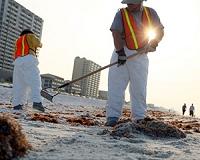| . |  |
. |
Miami (AFP) June 8, 2010 Huge plumes of crude from the Gulf of Mexico oil spill are hovering in the ocean depths, silently spreading their poison and slowly devastating the underwater ecosystem, scientists warned Tuesday. "Water samples taken by our research vessel in the area and analyzed by our experts and chemical oceanographers show large portions of oil deep in the ocean from 50 meters (yards) down to 1400 meters," University of South Florida (USF) oceanographer Yonggang Liu told AFP. "That oil in deep water is invisible to satellites," said Liu, who is taking part in a multi-disciplinary team of experts tracking the BP oil spill both at the surface and beneath the Gulf of Mexico. Just because the oil is hidden from view doesn't make it any less toxic to the environment, scientists said. On the contrary, it makes it practically impossible to clean up and render harmless. "You don't need more than logical thinking to see that the ecosystem in the deep waters of the Gulf will be affected. This would impact greatly the whole food chain, in lots of fishes that are sensitive and in the small creatures of the ocean," Liu said. Despite the warnings, BP maintains the oil spill is spreading mostly on the surface of the Gulf, but that claim does not seem to be bourne out by research. "The data speaks for itself," National Oceanic and Atmospheric Administration (NOAA) official Steven Murawski told a joint press conference with USF scientists on the team's observations in the Gulf. Samples taken by USF research ships at three sites northeast and southeast of the oil gusher up to a depth of one mile (1.6 kilometers) and off the coast of Louisiana show low concentrations of oil across all depths, the experts said. Suspended in ocean water, oil pollution poses a serious threat to floating plankton, as well as to marine plants and animals living at the bottom, including deep-sea corals, said scientists from University of Miami (UM) Division of Marine Geology and Geophysics. They said ocean water either stops the oil from rising to the surface or slows it down considerably, meaning that some of the oil mixed with dispersants BP uses to break up the spill, will never reach the surface where it can biodegrade faster. "The deep-water communities within the Gulf of Mexico and in the Straits of Florida are well hidden from us, but they include many species of cold-water corals that live at depths of 600-1500 meters (1,969-4,921 feet) in waters as cold as 3.0 degrees Celsius (37.4 Fahrenheit)," said UM scientist Gregor Eberli. "It is most likely that the delicate cold-water corals are not able to digest these oil-laden food particles and will perish in large numbers," he added. "Particularly vulnerable to disturbance are deep-sea fish that form part of this ecosystem because of their late maturation, extreme longevity, low fecundity and slow growth," Eberli said. National disaster coordinator, Coast Guard Admiral Thad Allen, warned Monday of the long-term environmental and ecological effects of the slick, which has broken into thousands of ribbons threatening shores from Louisiana to Florida. "Dealing with the oil spill on the surface will go on for a couple of months," Allen said. "Long-term issues of restoring environments and habitats and stuff will be years."
Share This Article With Planet Earth
Related Links Our Polluted World and Cleaning It Up
 Oil will damage southern US coast for years
Oil will damage southern US coast for yearsWashington (AFP) June 7, 2010 The long-term effects of the Gulf of Mexico oil spill will damage fragile ecosystems for years to come, US officials said Monday, as engineers successfully captured more crude from a broken wellhead. "Dealing with the oil spill on the surface will go on for a couple of months," said Admiral Thad Allen, who is coordinating the government's response to what has been called the worst environmen ... read more |
|
| The content herein, unless otherwise known to be public domain, are Copyright 1995-2010 - SpaceDaily. AFP and UPI Wire Stories are copyright Agence France-Presse and United Press International. ESA Portal Reports are copyright European Space Agency. All NASA sourced material is public domain. Additional copyrights may apply in whole or part to other bona fide parties. Advertising does not imply endorsement,agreement or approval of any opinions, statements or information provided by SpaceDaily on any Web page published or hosted by SpaceDaily. Privacy Statement |